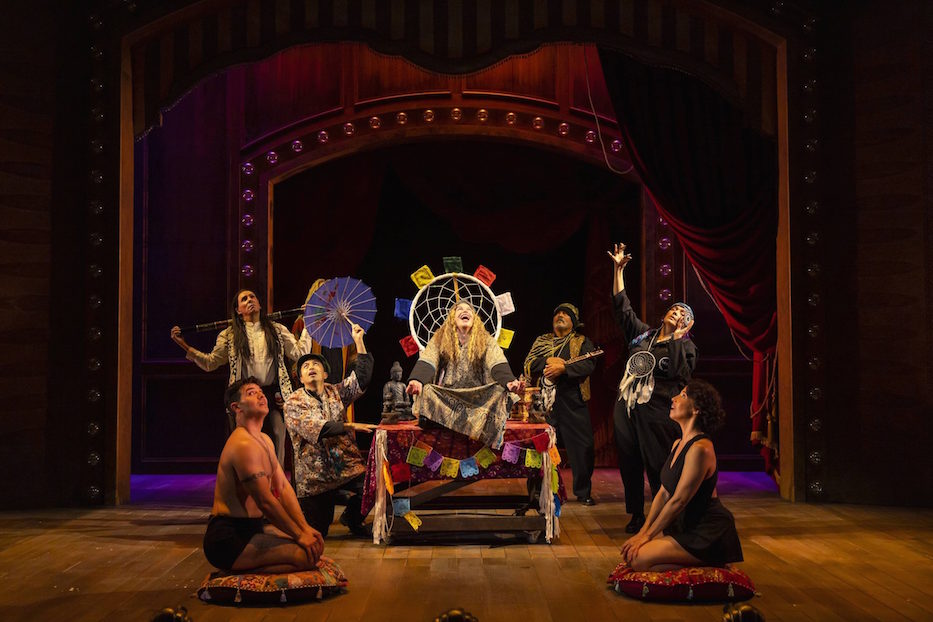
Arts & Culture | Theater | Yale Rep Theatre | Indigenous rights | Arts & Anti-racism
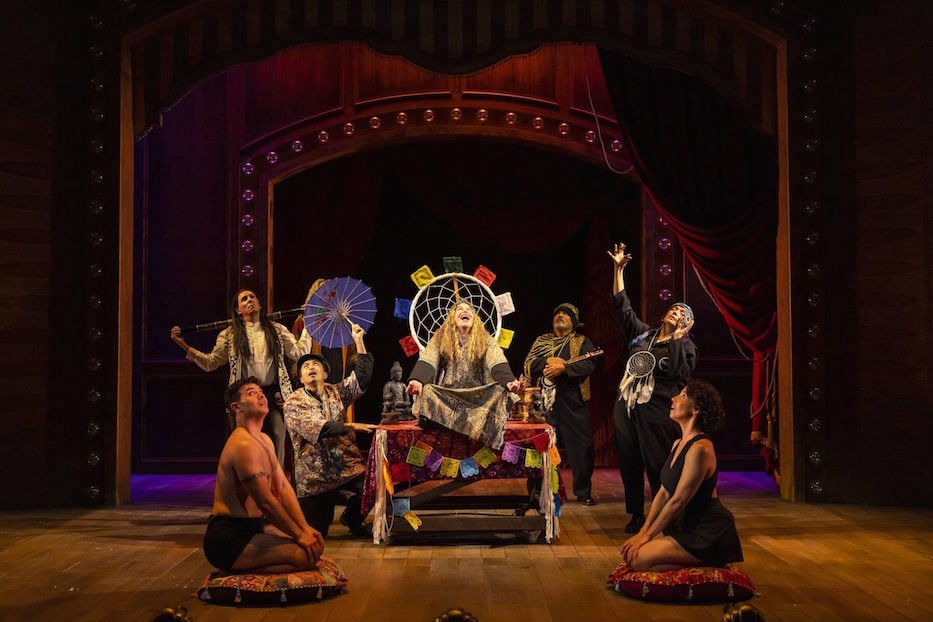
Cast members in a scene from BETWEEN TWO KNEES by The 1491s, directed by Eric Ting, Yale Repertory Theatre, May 12-June 4, 2022. Photo © T. Charles Erickson.
Irma (Shyla Lefner) cradles baby William Wolf in one arm, and lifts a clear jar of white tears above his tiny brow. Behind her, the chopped-off dreads of several white men wait to become part of this unlearning, a blessing in itself. She beams at her newborn son. When she looks back out at the audience for a beat, it’s hard not to laugh—and then to check the source of that laughter.
The long-running joke, after all, is about displacement, land theft, and generations of inherited trauma. If you can’t join in with Irma, well, that sounds about white.
Humor becomes a necessary, gorgeous, bitter, and incisive tool in Between Two Knees, running at the Yale Repertory Theatre through June 4. In the first full-length play from the sketch comedy troupe The 1491s, the work explores centuries of trauma, loss, forced migration, and white violence from an Indigenous perspective, using humor as a coping mechanism. By the end, it has become a unique and deeply overdue take on trauma response.
It is written by Ryan RedCorn, Sterlin Harjo, Dallas Goldtooth, Migizi Pensoneau, and Bobby Wilson and directed by Eric Ting. Tickets and more information are available here.
At its narrative core, Between Two Knees is a love story—to land, to people, and to enduring resistance— in which the fourth wall is constantly coming down. Narrated by Larry (Justin Gauthier) and an extremely nimble ensemble, it follows Irma (Shyla Lefner, and later Sheila Tousey) and Isaiah (Derek Garza, and later Wotko Long), teens who meet at a residential boarding school run by Catholics. In the long timeline that is Native history, the play begins at the Wounded Knee Massacre in late December 1890, and ends with the February 1973 American Indian Movement (AIM) “occupation” of the same land.
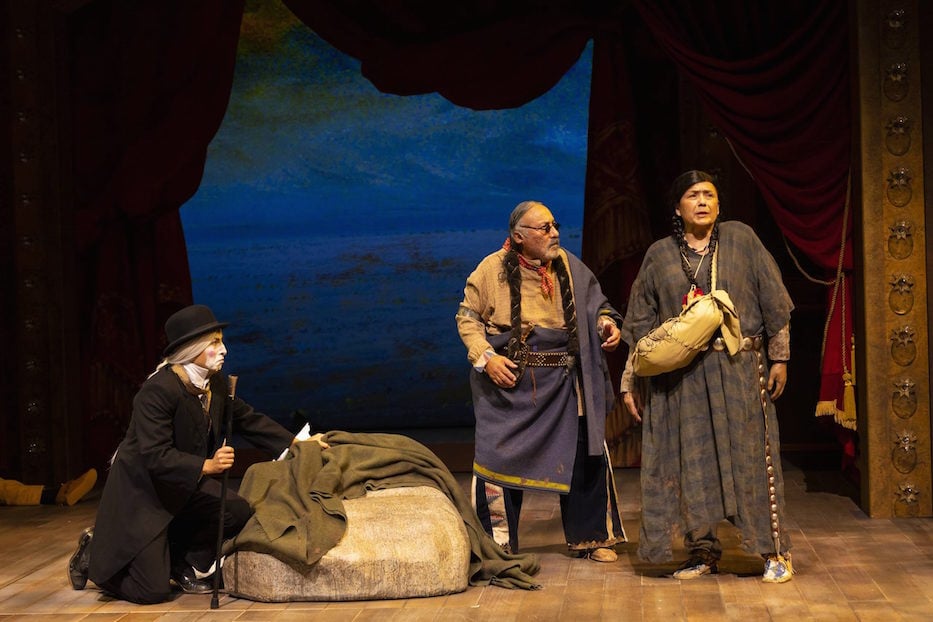
Shaun Taylor-Corbett, Wotko Long, and Sheila Tousey in BETWEEN TWO KNEES by The 1491s, directed by Eric Ting, Yale Repertory Theatre, May 12-June 4, 2022. Photo © T. Charles Erickson.
Both dates anchor a history that is layered, painful, and delivered with sharp and explosively creative wit. Isaiah has never met his mother, who was shot and fatally injured at Wounded Knee. Irma, who meets her in a vision, is ready to break free from this regimented, vicious white world. In the generations they create is the seed of the story, and its winding, surprisingly funny, sometimes heart-rending path home.
The narrative becomes a springboard for history. In building a life together, Isaiah and Irma take a living, centuries-long wound and tear it all the way open. With the help of a shape-shifting, forward-imagining ensemble, they guide the audience through a history of stolen land (that was then cultivated by stolen people), separated families, substance use disorder, appropriation versus appreciation, multigenerational trauma and multigenerational resistance.
For every misplaced utterance of “We are a nation of immigrants” that echoes through New Haven (yes members of the Wooster Square Monument Committee, this reporter saw you in the audience), this work is the antidote and then some.
It is how ensemble members tell that story, with deep physicality and punch, that makes the show such a timely and refreshing meditation on white supremacy. From the moment actors introduce the show, they address widespread misconceptions and stereotypes of Indigenous culture and history, from traditional clothing and ritual to the service of Native people in the U.S. Military. “White people, I know you’re out there—I can smell you,” Larry announces, breaking the ice on what will be the first of many uneasy laugh lines.
In a pre-show announcement, a voiceover acknowledges how rote and milquetoast land acknowledgements have become, as if they are now part of general theater procedure alongside mask mandates and fire exits. Instead, it directs audience members to their programs, where a color-coded, carefully labeled map of the state lists tribes that stewarded the land for generations. They include 20 tribes, notably more than the five that are officially recognized by the state of Connecticut in the present.
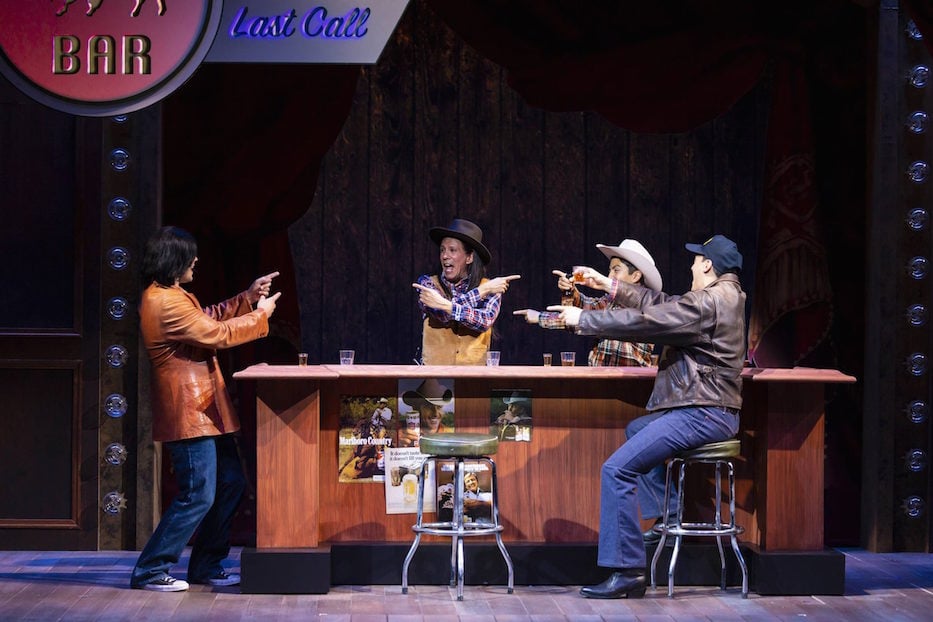
Derek Garza, Justin Gauthier, Shaun Taylor-Corbett, and Edward Astor Chin BETWEEN TWO KNEES by The 1491s, directed by Eric Ting, Yale Repertory Theatre, May 12-June 4, 2022. Photo © T. Charles Erickson.
As it unfolds, the work is more of a series of vignettes than a cohesive whole—but never to the play’s detriment. There are some sequences that feel more like Dr. Who than a dramatized version of Love Medicine or The Beet Queen and others that feel pulled right from the Pine Ridge Reservation on which Irma and Isaiah live. In it, there is no monolithic Indigenous voice, just as there is no such thing as “the Black vote.” It feels like a nod to the porous nature of the past—and the possibility of the future—that works.
Nothing in the white, male, cisgender “mainstream” is sacred here, and it’s about dang time (truthfully, it’s been about time since the 15th century). From its first scene, Between Two Knees pokes fun at the fabric of Christianity and organized religion, white (mis)perceptions of Indigeneity, a residential school system so cruel that it became a blueprint for the Nazis, and the absurdity and harm in the aspiration to whiteness itself. It does so with sinister panache, from a “Wheel of Massacre” game show to Kung Fu fighting nuns to a crash course in the American Indian Movement done through the fuzzy lens of a video camera.
In one particularly funny scene, Irma and Isaiah have searched for an “Indian wedding specialist,” but found someone who is more surfer-meets-dharma-bro than anything else. As they kneel then stand for their nuptial vows, the specialist’s assistants keep coming between them, banging a series of drums, chimes, and small instruments in their faces. There’s nothing Indigenous about this wedding rite—but they tolerate it, just as they have tolerated whiteness so many times before.
In others, the play’s humor and alive-ness lives alongside its depth and tragedy. Isaiah and Irma have good love, but it’s tested when their son and grandson both get caught in the gnashing teeth of the military industrial complex. Larry’s narration is funny until it’s not, and laughter takes on a chilled, sharp edge. When the older Isaiah (Long) opens Act II with a flute riff on Pocahontas, which romanticizes the real-life marriage of Pocahontas and the land-grabbing settler-colonizer low key pedophile John Rolfe shortly before the arrival of the first enslaved Africans in the United States, it doesn’t feel like it could be any other way.
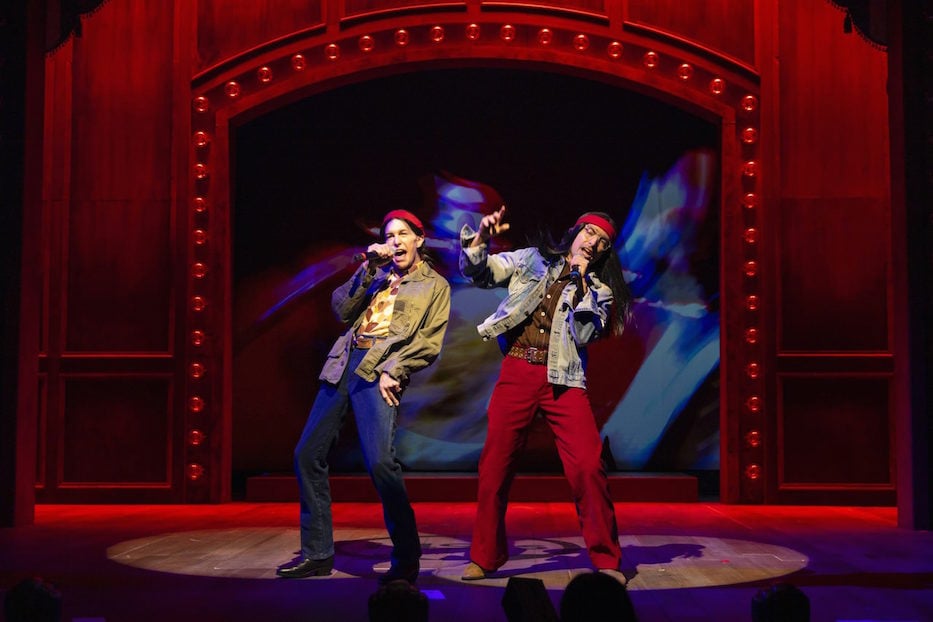
Rachel Crowl and Shaun Taylor-Corbett in BETWEEN TWO KNEES by The 1491s, directed by Eric Ting, Yale Repertory Theatre, May 12-June 4, 2022. Photo © T. Charles Erickson.
All of it is couched in a dizzying, deeply unsettling history. Regina García’s set-within-a-set, designed to look like a carnival tent, becomes an unspoken character with larger-than-life reminders of Native mascots, brand ambassadors (remember the Land O’ Lakes “Butter Maiden?”) and twentieth-century cartoon depictions that lived for years on the airwaves. It’s a constant reminder of how extractive white America has been, using Native caricature for profit while also ensuring that Native people remain poor.
Credit is also due here to an immensely able creative team, including costume designer Lux Haac, projections designer Shawn Duan, scenic designer García and dramaturg Julie Felise Dubiner. Sound from Jake Rodriguez and lighting from Elizabeth Harper remind viewers constantly of how real and also theatrical this world is. García’s design is a thing of beauty and quirk, with a stage that opens up and then swallows actors gradually.
Between Two Knees also practices what it preaches. Ensemble members are all Indigenous with the exception of Edward Astor Chin, whose own identity becomes fodder for a cheeky quip about the mass slaughter and continued economic disenfranchisement of Indigenous people. “Do you know how hard it was to cast this?” Larry says, and the specter of settler-colonialism is everywhere.
Throughout, several standout performances become the glue of the show. As both young Irma and Irene, Lefner is extremely nimble, able to switch characters on a dime and give all of them the same emotional depth. As young Isaiah, Garza radiates a boyish energy that vibrates beneath his skin, but can dial it back to be incredibly quiet and sweet. In both ensemble roles and as the older version of Isaiah, Long is sharp and funny, with a real ear for silence, sound, and pacing. Gauthier holds everything together, juggling each part of the play at once.
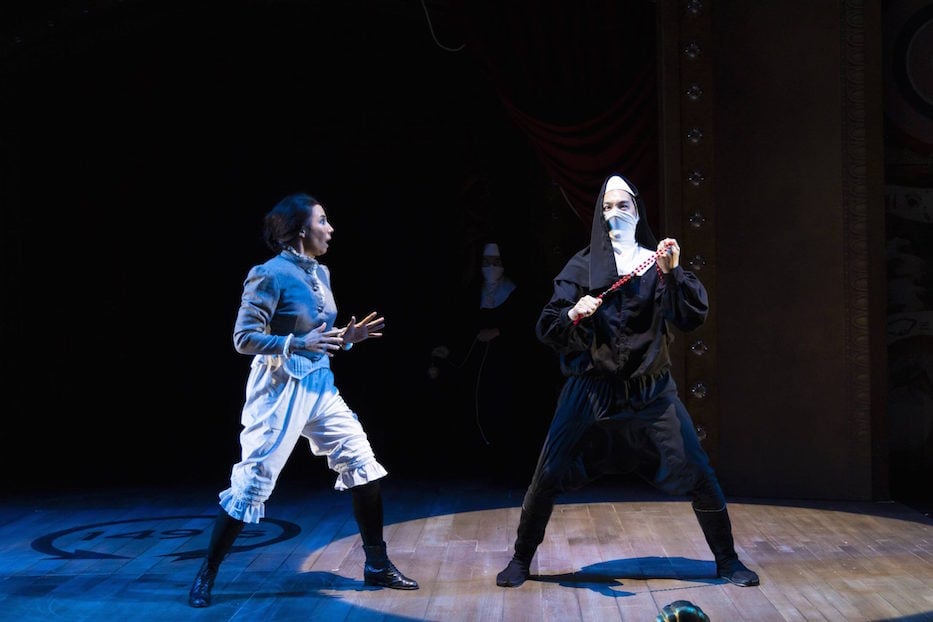
Shyla Lefner and Edward Astor Chin in Between Two Knees by The 1491s, directed by Eric Ting, Yale Repertory Theatre, May 12-June 4, 2022. Photo © T. Charles Erickson.
They highlight an equally adept ensemble, with members that power through multiple costume changes, a set with parts beneath the stage, and shifts in time like it’s no big deal (it appears there is literally nothing that Rachel Crowl cant do). During one recent performance, they did so in masks, rolling with a Covid-19 exposure that had taken place within the cast.
The question that lingers, long after the curtain has fallen, is what both the Yale Rep, the audience, and the $43 billion bouncy castle of an institution to which they are tethered will choose to do with this witness and whiteness going forward. With works like Manahatta and now Between Two Knees, the Rep is actively investing in Indigenous theatermakers, giving them a chance to take up space in a historically white institution.
But where does this go after that? Is there a world in which the Rep would ever pilot a voluntary white people charge or even a sliding scale based on wealth and privilege? What about a patriarchy fee? Can New Haveners expect next season to include a discussion around spatial and monetary reparations? What about sustained audience engagement for people who don't look like the descendants of Elihu Yale?
Does the conversation stop after the curtain has fallen, and the unsettled laughter has settled?

